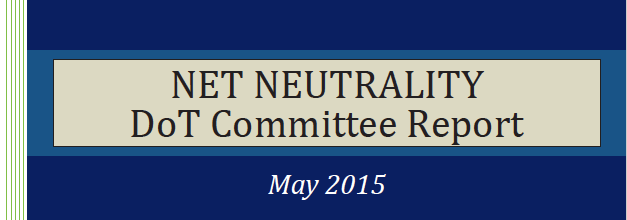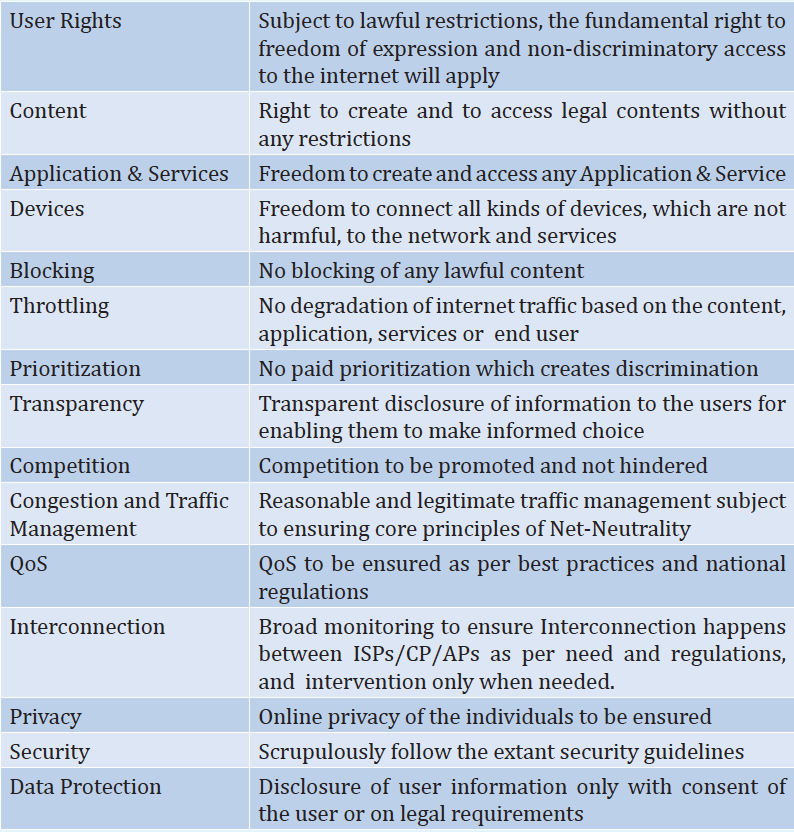India Issues Net Neutrality Report
After taking comments from interested parties (including your faithful correspondent), India’s Department of Telecommunications has issued a committee report outlining a high-level approach. The report spends most of its time summarizing the views of the various commenters – civil society, telecoms, application providers – before laying out general guidelines. Our previous posts on this issue are here and here.
One very hot issue is raised and then not settled: should providers of over-the-top (OTT) voice services be regulated the same way as plain old telephone services?
DoT takes the clear position that OTT messaging services, such as WhatsApp, should remain deregulated, but stumbles on OTT voice. While DoT is willing to keep Skype deregulated for international calls, it wants to reserve the option of regulating local calling by OTT apps the same way that POTS calls are regulated. It says it wants to have this option to foreclose regulatory arbitrage, where a Telecom Service Provider (TSP) or ISP shifts its calling function from POTS to VoIP to escape regulation; the term “regulatory arbitrage” is used. There will be a further enquiry on this question.
DoT also says it wants to legitimize international QoS standards such as the IntServ-based (which is to say, Internet standards-based) eight bearer classes defined by ITU for mobile broadband. Here’s a chart summarizing the approach.
There’s one glaring inconsistency in the document. While it endorses “international best practices” for QoS management per ITU, it also declares that there can’t be any “application based discrimination” on the Internet service. The report does a great job of explaining how QoS works on broadband networks and why it’s important to India for ISPs to manage traffic. Unlike other countries, most of India’s Internet access is from mobile devices, and the networks that serve these devices are spectrum-constrained. So India has an iPhone-era Internet, while other countries (the US included) are still in pre-iPhone stage as far as policy is concerned. The FCC’s recent net neutrality rules have a strong wired network bias, which we see in the order’s ultra-narrow managed services (or “non-Broadband Internet Access Service Data Services” in the order’s clumsy nomenclature) exemption.
India gets why managed services are important: this is how employees working off-site contact the company network, it’d how companies bring network resources to their employees, and how companies build multi-site networks. Most Internet use with real economic impact takes place over managed services, and this form of communication can’t be compromised just to make it easier for the entertainment resellers to make money hand over fist. India’s a young democracy with a heavily regulatory history, but they get this while Chairman Wheeler and his staff don’t.
The DoT frames its recommendations in unique way: it defines each one according to one of the Buddha’s commandments in the so-called Eigthfold Path that defines Buddhism’s Middle Way. You have to see this (page 83).
India is the land of Buddha who preached the Middle Path. Some tenets of His Eightfold Middle Path are important – right understanding, right thought, right speech, right action, right mindfulness and right efforts. In the context of Net Neutrality, the approach of the Committee has been as follows:
i. Right Understanding – Understanding needs of all stakeholders, their views and concerns, participative policy formulation
ii. Right Thought – Build and support an open, free, innovative, non-discriminatory and inclusive Internet
iii. Right Speech – No throttling and blocking of the lawful content on the net. Support freedom on the Internet with reasonable safeguards within constitutional parameters.
iv. Right Action – Enshrine core principles of Net Neutrality in current operable mechanism. Use well established processes for implementation, enforcement and oversight
v. Right Mindfulness – Provide for reasonable and legitimate traffic management but disallow paid prioritisation. Prescribe and ensure right QOS and transparency requirements
vi. Right Livelihood – Promote innovation as well as investment. User rights and business models align to deliver progress. Test tariffs against core principles of Net Neutrality
vii. Right Concentration – Keep watch on disruptive changes that technology brings and adapt. Level playing issues need level headed approach
viii. Right Efforts – Leave infrastructure development and application or content development to those who are best capable of doing it. Regulatory boundaries between the two should be finely calibrated. Build capacity and capability within.
The report also stresses the importance of philosophy in public policy:
In order to follow this Middle Path, in order to explore the best possible options to create a virtuous cycle, we must embrace change and move forward and towards Dharma i.e. maintaining transparency, neutrality, privacy, security and the democratic fabric of the Internet. At times, philosophy provides answers to the larger questions of freedoms, equality and choice raised by disruptions through advancements in technology and commerce. The Committee hopes that this philosophy has imbued its approach to its recommendations on the issue of neutrality of the Internet.
“Dharma” is a Sanskrit word that roughly translates as duty, destiny, and “right livelihood.” It’s peculiar to see references to Buddhism in an Indian policy text since that religion was all but wiped out in India 800 years ago.
It’s unclear whether this policy will enable the Internet to flourish in India or if it will send it to exile as was the fate of Buddhism.
On the one hand it says:
10.3 ITU has published various recommendations for differential treatment of network traffic on transport networks and their effect on user experience, like the ITU-T G.1010 recommendation, which defines the multimedia QoS categories from an end user viewpoint and M.1079, which defines the categories in IMT-2000 mobile environment. These recommendations form the basis for defining realistic QoS classes for underlying transport networks and QoS control mechanisms. According to G.1010 recommendation, the key parameters which impact users are delay, delay variation and information loss, which need to be minimized. For this purpose various types of traffic can be classified into 8 classes. Some classes are error tolerant and some are not. The traffic in each class can tolerate only certain delay, jitter and packet loss characteristics. Therefore, the priority and QoS have to be attributed accordingly with highest priority to voice and video traffic and lowest priority to non-critical background services. Therefore, it is necessary to distinguish the different types and treat them accordingly.
But on the other it also says: “In general, for legitimate network management, application-agnostic control may be used. However, application-specific control within the “Internet traffic” class may not be permitted.”
I really don’t see how you can have it both ways without regarding all traffic classes other than the default class for Internet service as regulated OTT voice-equivalents. That would defeat the utility of non-default traffic classes for innovation.
It appears that India has ways to go yet.




